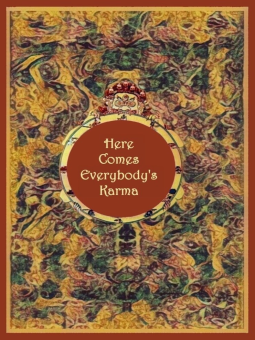
Here Comes Everybody's Karma
by Shaharee Vyaas
This title was previously available on NetGalley and is now archived.
Send NetGalley books directly to your Kindle or Kindle app
1
To read on a Kindle or Kindle app, please add kindle@netgalley.com as an approved email address to receive files in your Amazon account. Click here for step-by-step instructions.
2
Also find your Kindle email address within your Amazon account, and enter it here.
Pub Date Jun 11 2024 | Archive Date Oct 15 2024
Bostoen, Copeland & Day Ltd | Bostoen, Copeland & Day
Description
This publication is the result of a literary art experiment that aims to merge the most beautiful publication in English literature with its most enigmatic one. The result of this endeavor has been condensed in this retelling of Finnegans Wake as Here Comes Everybody's Karma.
It is widely agreed upon that the Kelmscott-Chaucer is the most beautiful book ever printed and that Joyce's Finnegan's Wake is the most ingenious one (or vilified one: depending upon one's personal opinion for what is appropriate English literature).
Weirdly enough, both publications seem to suffer from a rather uncommon literary defect that has been defined as: their readability!
The Kelmscott Chaucer used Walter William Skeat's edition of the complete Chaucer, after explaining to the delegates of the Clarendon Press that his edition was intended to be an "art object" and would not compete with their six-volume edition of Skeat's edition of Chaucer's complete works. It contains 87 wood engravings of drawings by Edward Burne-Jones. Peter Faulkner, a William Morris expert, expressed his preference for The Canterbury Tales by the Golden Cockerel Press, noting that in the Kelmscott Chaucer, "the two sixty-three-line columns of 12-point type on the large page do not make for easy reading."
Joyce claimed that by writing Finnegans Wake he was attempting to "reconstruct the nocturnal life", and that the book was his "experiment in interpreting 'the dark night of the soul'." Alas, for most lovers of English literature, he (subconsciously?) created a reader's ultimate nightmare.
The impression exists that only accomplished philologists have ever managed to decipher the novel's polysemantic vocabulary that was borrowed from approximately sixty-five languages and dialects.
This retelling is an effort to remediate those issues while enhancing their inherent qualities.
Evolutions in modern printing techniques have allowed to elevate this offspring of the Kelmscott-Chaucer from its black and white corset while avoiding the typographic setting that made for a difficult reading experience.
The foreign language idiosyncrasies in Finnegans Wake have been replaced by their English equivalent and Joyce's sibylline prose has been streamlined into a more fluid syntaxis.
Where Joyce proclaimed that the novel's cyclical nature is best demonstrated by the feature that it begins and ends in the middle of a sentence, this retelling expresses the cyclical nature of the tale by beginning and ending in connecting circumstances and its graphic layout.
Also, the colors of the decorative frames of each chapter are evolving in consecutive shades as they appear on the color wheel, with the color of the frames of this introduction featuring the frame-colors of the last chapter of this novel, while having a slightly different design.
Last but not least, the titles of this retelling, books and chapters, want to inspire the readers to rethink the whole tale into the context of the Asiatic philosophical concepts of Karma and Dharma, which are interacting cyclical principles.
That mentioned, Here Comes Everybody's Karma is a novel that tends to grow into the mind of the reader and therefore should be consumed at a leisurely pace to avoid a literary indigestion.
Enjoy!
Available Editions
| EDITION | Paperback |
| ISBN | 9781737783299 |
| PRICE | €49.00 (EUR) |
| PAGES | 566 |
Available on NetGalley
Average rating from 4 members
Featured Reviews
 Reviewer 1394760
Reviewer 1394760
I initially decided not to give feedback upon receiving this copy. It was one of the first books that I had requested on NetGalley and I thought the description was interesting based on my personal interest. After receiving the copy, I realised that something in the digitalisation of the text went wrong, and the font was blurry. Everything is in low resolution. I let the publisher know of this and my decision.
Then I kept coming back to this book, and used the writer’s website for a much clear reading of the excerpts. First of all, the paintings are wonderful. If you are interested in Finnegan’s Wake, this is a modernised version that can be slowly cherished and analysed.
 J F, Reviewer
J F, Reviewer
As is indicated in the description of Here Comes Everybody’s Karma the author, Shaharee Vyaas approached this book as a literary art experiment. Vyaas wanted to know what would emerge if you took two books. One which has been called the most beautiful book published – The Kelmscott Chaucer and the second that has been called the most ingenious (or vilified yet remarkable) book published – James Joyce’s Finnegans Wake.
Each of these books have been subject to criticism. The Kelmscott, though beautiful, makes for difficult reading due to the typeset. Although, it has to be said that William Morris published The Kelmscott for its artistry. Similarly, Finnegans Wake is considered very difficult to read although the reasons for this are less about formatting than about the modernist stream of thought approach and the way that Joyce made up words using multiple languages.
In this retelling the author wants to make it a clear and readable story retaining the beauty of the Kelmscott and the originality and humour of the Joyce. Also, to relate this interpretation, this retelling, to the Asiatic concepts of Karma and Dharma.
So with all this Here Comes Everybody’s Karma (HCEK) has been brought to life.
At 566pp it’s not for the faint hearted!
With regard to The Kelmscott Chaucer that is an easier, visual comparison and I can quickly say that I believe that HCEK compares favourably on two counts. The first is readability and HCEK certainly has done that with much better typesetting yet still retaining an elegant font. It has also been written in English and so does not have the ‘made up’ language issue of the Joyce.
The second is with regard to how beautiful HCEK is. Well the author has similar borders to which colour has been introduced. The colour of the borders are those of the colour wheel which also gives an added nod to the cyclical element of Finnegans Wake (which starts and ends with the same half sentence) as the sections move through the wheel. The Kelmscott was printed in black on white paper or on vellum and the pictorial element was from hand carved wood blocks which make for some stunning artwork (see below for a link to The Kelmscott Chaucer online provided by Michael John Goodman) whilst Shaharee Vyaas has taken full advantage of modern technology to display his artwork in HCEK.
I have not read Finnegans Wake which, when invited to read HCEK, I was very open with the author about. So I have taken the points made in the authors description of his aims for his work and made my comments. The book is certainly readable and I found the overall project interesting. I didn’t know The Kelmscott Chaucer and found that looking into it was a fascinating element. I was engaged when reading about Finnegans Wake to get some understanding of why this is such an enigmatic story.
Here Comes Everybody’s Karma is also such a story. It is a not a simple read nor is it unreadable from the point of view of the language and typesetting. It has humour, it is cyclical in its telling and as already indicated in colour, it is a handsome book which gives the reader a sense of the free flowing mind of the author and I can see how this relates in its way to the modernist style of Joyce. The author has characters and other elements, for example, Asian food, culture and religion that give a slight nod towards the philosophical principles of Karma and Dharma. It’s not a great leap to see why Vyaas feels Finnegans Wake with its cyclical implications would be a good fit.
Indeed, it’s in life and death we see cycles – how birth then death then birth again – are found continually in nature; our old sayings such as ‘what goes around, comes around’, ‘you reap what you sow’ – the rhythm of life if you like. Also, we can influence some things, we choose to do or not to do things and that, in its turn has an influence on our lives and the lives of others. This is, as I understand it, we’re Karma and Dharma come in and so we could choose to look at Finnegans Wake from this philosophical point of view.
So, in his retelling, this is what the author has tried to achieve and given that we are told this we can certainly choose to look at it with that point of view as it is incorporated into Here Comes Everybody’s Karma. Perhaps this might raise a few eyebrows for Joyce fans but I would hope that they and all readers would take it in the spirit intended.
I didn’t find this the easiest as it’s not what I might normally read but I did find it fascinating and I enjoyed thinking on the authors ideas and looking into the various aspects (see below for just some examples of where my mind wandered) and whilst I’m not sure I have done complete justice to HCEK I have certainly enjoyed the journey and hope that, at least, comes across.
Thanks
Thank you to Shaharee Vyaas for inviting me to read Here Comes Everybody’s Karma and also to Bostoen, Copeland & Day for providing a copy of the book via NetGalley and a further updated eCopy.
Rating: 3.5*
 J. K, Reviewer
J. K, Reviewer
Thanks to the publisher and Netgalley for this eARC.
“Here Comes Everybody’s Karma” by Shaharee Vyaas is an ambitious literary experiment that seeks to merge the aesthetic beauty of the Kelmscott Chaucer with the enigmatic complexity of James Joyce’s “Finnegans Wake.” This unique retelling offers a fresh perspective on two of English literature’s most revered works, making it a fascinating read for literary enthusiasts and scholars alike.
Vyaas embarks on a bold journey to reinterpret “Finnegans Wake,” a novel notorious for its dense and challenging prose, by infusing it with the visual and structural elegance of the Kelmscott Chaucer. The result is a work that not only pays homage to its sources but also stands as a testament to the transformative power of literary art.
The book’s structure is one of its most striking features. Vyaas employs a cyclical narrative that begins and ends in connecting circumstances, mirroring the original’s intent but with a more accessible approach. The evolving color frames for each chapter add a visual dimension that enhances the reading experience.
One of the primary challenges of “Finnegans Wake” is its polysemantic vocabulary and complex syntax. Vyaas addresses this by streamlining the prose and replacing foreign language idiosyncrasies with their English equivalents. This makes the text more approachable while retaining its rich, layered meanings.
The integration of visual elements from the Kelmscott Chaucer elevates the book to an art object. The decorative frames and illustrations are not merely ornamental but serve to deepen the reader’s engagement with the text.
Vyaas does not shy away from the philosophical and existential themes that permeate “Finnegans Wake.” Instead, he embraces them, offering insights that are both profound and thought-provoking. This makes “Here Comes Everybody’s Karma” a rewarding read for those willing to delve into its depths.
Vyaas’ writing is lyrical and precise. He manages to capture the essence of Joyce’s experimental style while making it more digestible for contemporary readers. His ability to balance complexity with clarity is commendable, making this book a bridge between the past and the present.
“Here Comes Everybody’s Karma” is a remarkable achievement that reimagines two literary masterpieces in a way that is both respectful and innovative. Shaharee Vyaas has created a work that is not only a tribute to Joyce and the Kelmscott Chaucer but also a standalone piece of literary art.


















